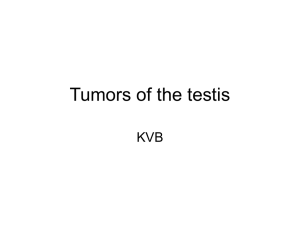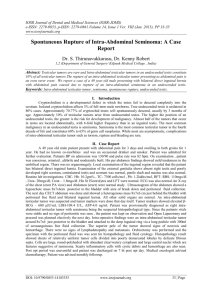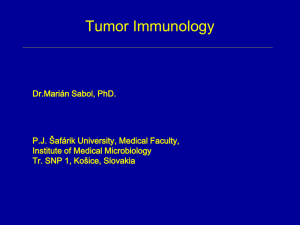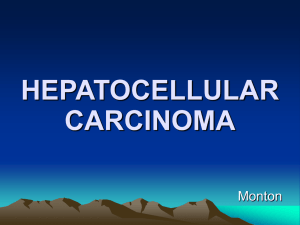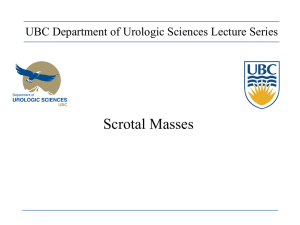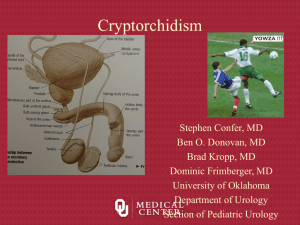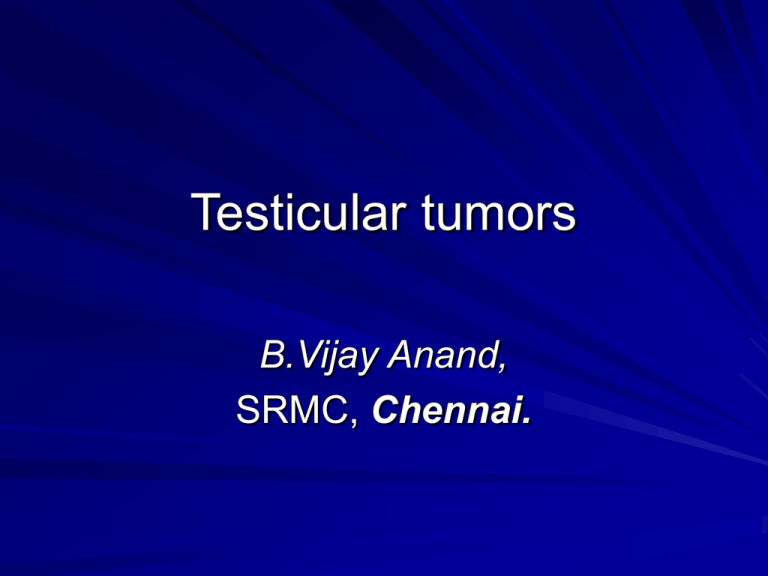
Testicular tumors
B.Vijay Anand,
SRMC, Chennai.
Incidence
Testicular tumors are rare.
1 – 2 % of all malignant tumors.
Most common malignancy in men in the 15 to 35
year age group.
Benign lesions represent a greater percentage
of cases in children than in adults.
Age - 3 peaks
2 – 4 yrs
20 – 40 yrs
above 60 yrs
Testicular cancer is one of the few neoplasms
associated with accurate serum markers.
Most curable solid neoplasms and serves as a
paradigm for the multimodal treatment of
malignancies.
Etiology
Cryptorchidism
Intersex disorder
Testicular atrophy
Trauma- prompts medical evaluation
Chromosomal abnormalities - loss of
chromosome 11, 13, 18, abnormal chromosome 12p.
Sex hormone fluctuations, estrogen
administration during pregnancy
CROSS SECTION OF
TESTIS
Testis
Stroma
Interstitial Cells
Seminiferous Tubules
(200 to 350 tubules)
Supporting
Leydig
(Androgen)
Spermatogonia
or
Sertoli Cell
CLASSIFICATION
I.Primary Neoplasms of Testis.
A. Germ Cell Tumor.
B. Non-Germ Cell Tumor .
II.
Secondary Neoplasms.
III.
Paratesticular Tumors.
Germ cell tumors
1. Seminomas - 40%
(a) Classic Typical Seminoma
(b) Anaplastic Seminoma
(c) Spermatocytic Seminoma
2. Embryonal Carcinoma - 20 - 25%
3. Teratoma - 25 - 35%
(a) Mature
(b) Immature
4. Choriocarcinoma - 1%
5.
Yolk Sac Tumour
Classification of germcell tumor
(GCT)
GCTs arise from pluripotential cells, so a
variety of elements may habitate in
primary tumor
More than half of GCTs contain more than
one cell type and are therefore known as
mixed GCTs
Sex cord/ gonadal stromal tumors
( 5 to 10% )
1. Specialized gonadal stromal tumor
(a) Leydig cell tumor
(b) sertoli cell tumor
2. Gonadoblastoma
3. Miscellaneous Neoplasms
(a) Carcinoid tumor
(b)
Tumors of ovarian epithelial sub
types
II. SECONDARY NEOPLASMS OF TESTIS
A.
B.
Reticuloendothelial Neoplasms
Metastases
III.
PARATESTICULAR NEOPLASMS
A.
B.
C.
D.
E.
Adenomatoid
Cystadenoma of Epididymis
Desmoplastic small round cell tumor
Mesothelioma
Melanotic neuroectodermal
Carcinoma insitu {CIS}
Pre invasive precusor of all GCT, except
spermatocytic seminoma
Incidence of CIS in the male population is 0.8%.
Testicular CIS develops from fetal gonocytes &
is characterized histologically by seminiferous
tubules containing only Sertoli cells and
malignant germ cells.
Patients at risk of CIS
History of testicular carcinoma (5% to 6%),
Extra gonadalGCT (40%),
Cryptorchidism (3%),
Contralateral testis with unilateral testis cancer
(5% to 6%),
Somatosexual ambiguity (25% to 100%)
Atrophic testis 30 %
Infertility (0.4% to 1.1%)
TESTICULAR BIOPSY gold standard for
diagnoses of CIS
Lymphatic drainage
The primary drainage of the right testis is
within the interaortocaval region.
Left testis drainage , the para-aortic region
in the compartment bounded by the left
ureter, the left renal vein, the aorta, and
the origin of the inferior mesenteric artery.
Cross over from right to left is possible.
Lymphatic drainage
Lymphatics of the epididymis drain into the external iliac
chain.
Inguinal node metastasis may result from scrotal
involvement by the primary tumor, prior inguinal or
scrotal surgery, or retrograde lymphatic spread
secondary to massive retroperitoneal lymph node
deposits.
Testicular cancer spreads in a predictable and stepwise
fashion, except choriocarcinoma.
.
Clinical features
Painless Swelling of One testis
Dull Ache or Heaviness in Lower Abdomen
10% - Acute Scrotal Pain
10% - Present with Metatstasis
- Neck Mass / Cough / Anorexia / Vomiting /
Back Ache/ Lower limb swelling
5% - Gynecomastia
Rarely - Infertility
Physical Examination
Examine contralateral normal testis.
Firm to hard fixed area within tunica albugenia is
suspicious
Seminoma expand within the testis as a
painless, rubbery enlargement.
Embryonal carcinoma or teratocarcinoma may
produce an irregular, rather than discrete mass.
Differential Diagnosis
Testicular torsion
Epididymitis, or epididymo-orchitis
Hydrocele,
Hernia,
Hematoma,
Spermatocele,
Syphilitic gumma .
DICTUM FOR ANY SOLID SCROTAL
SWELLINGS
All patients with a solid, Firm
Intratesticular Mass that cannot be
Transilluminated should be regarded
as Malignant unless otherwise
proved.
Scrotal ultrasound
Ultrasonography of the scrotum is a rapid,
reliable technique to exclude hydrocele or
epididymitis.
Ultrasonography of the scrotum is basically an
extension of the physical examination.
Hypoechoic area within the tunica albuginea is
markedly suspicious for testicular cancer.
Cystic lesion- epidermoid cyst
Tumor markers
TWO MAIN CLASSES
Onco-fetal Substances : AFP & HCG
Cellular Enzymes : LDH & PLAP
AFP - Trophoblastic Cells
HCG - Syncytiotrophoblastic Cells
( PLAP- placental alkaline phosphatase, & LDH lactic acid
dehydrogenase)
AFP –( Alfafetoprotein)
NORMAL VALUE: Below 16 ngm / ml
HALF LIFE OF AFP – 5 and 7 days
Raised AFP :
Pure embryonal carcinoma
Teratocarcinoma
Yolk sac Tumor
Combined tumors,
AFP not raised in pure choriocarcinoma , & in
pure seminoma
HCG – ( Human Chorionic Gonadotropin)
Has and polypeptide chain
NORMAL VALUE: < 1 ng / ml
HALF LIFE of HCG: 24 to 36 hours
RAISED HCG 100 %
- Choriocarcinoma
60%
- Embryonal carcinoma
55%
- Teratocarcinoma
25%
- Yolk Cell Tumour
7%
- Seminomas
ROLE OF TUMOUR MARKERS
Helps in Diagnosis - 80 to 85% of Testicular Tumours
have Positive Markers
Most of Non-Seminomas have raised markers
Only 10 to 15% Non-Seminomas have normal marker
level
After Orchidectomy if Markers Elevated means Residual
Disease .
Elevation of Markers after Lymphadenectomy means a
STAGE III Disease
ROLE OF TUMOUR MARKERS
Degree of Marker Elevation Appears to be Directly
Proportional to Tumor Burden
Markers indicate Histology of Tumor:
If AFP elevated in Seminoma - Means Tumor has NonSeminomatous elements
Negative Tumor Markers becoming positive on follow up
usually indicates - Recurrence of Tumor
Markers become Positive earlier than X-Ray studies
Imaging studies
Chest X ray
CECT abdomen – retroperitoneal nodes
PET- No apparent advantage over CT
MRI - No apparent advantage over CT
Large left para aortic nodal mass due to
GST causing hydronephrosis
Tumor staging
Primary Tumor (T)pTX - Primary tumor cannot be
assessed (if no radical orchiectomy has been performed,
TX is used)
pT0 - No evidence of primary tumor (e.g., histologic scar
in testis)
pTis - Intratubular germ cell neoplasia (carcinoma in situ)
pT1 - Tumor limited to the testis and epididymis and no
vascular/lymphatic invasion
pT2 - Tumor limited to the testis and epididymis with
vascular/lymphatic invasion or tumor extending through
the tunica albuginea with involvement of tunica vaginalis
pT3 - Tumor invades the spermatic cord with or without
vascular/lymphatic invasion
pT4 - Tumor invades the scrotum with or without
vascular/lymphatic invasion
Regional Lymph Nodes
Clinical NX - Regional lymph nodes cannot be
assessed
N0 - No regional lymph node metastasis
N1 - Lymph node mass 2 cm or less in greatest
dimension or multiple lymph node masses, none
more than 2 cm in greatest dimension
N2 - Lymph node mass, more than 2 cm but not
more than 5 cm in greatest dimension, or
multiple lymph node masses, any one mass
greater than 2 cm but not more than 5 cm in
greatest dimension
N3 - Lymph node mass more than 5 cm in
Pathologic node staging
pN0 - No evidence of tumor in lymph nodes
pN1 - Lymph node mass, 2 cm or less in greatest
dimension and ≤6 nodes positive, none >2 cm in
greatest dimension
pN2 - Lymph node mass, more than 2 cm but not more
than 5 cm in greatest dimension; more than 5 nodes
positive, none >5 cm; evidence of extranodal extension
of tumor
pN3 - Lymph node mass more than 5 cm in greatest
dimension.
Distant metastasis
M0 - No evidence of distant metastases
M1 - Nonregional nodal or pulmonary
metastases
M2 - Nonpulmonary visceral masses
Serum tumor markers
LDH
S0
_< N
HCG
Miu/ml
<N
AFP
Ng/ml
<N
S1
<1.5 x N
< 5000
< 1000
S2
1.5-10x N
S3
>10x N
5000 to
50000
> 50000
1000 to
10000
>10000
PRINCIPLES OF TREATMENT
Treatment should be aimed at one stage above
the clinical stage
Seminomas Radiotherapy.
Radio-Sensitive.
Treat
with
Non-Seminomas are Radio-Resistant and best
treated by Surgery
Advanced Disease or Metastasis - Responds
well to Chemotherapy
PRINCIPLES OF TREATMENT
Radical INGUINAL ORCHIDECTOMY is
Standard first line of therapy
Lymphatic spread initially goes to
RETRO-PERITONEAL NODES
Early hematogenous spread RARE
Bulky Retroperitoneal Tumours or Metastatic
Tumors Initially “DOWN-STAGED” with
CHEMOTHERAPY
PRINCIPLES OF TREATMENT
Transscrotal biopsy is to be condemned.
The inguinal approach permits early
control of the vascular and lymphatic
supply as well as en-bloc removal of the
testis with all its tunicae.
Frozen section in case of dilemma.
CHEMOTHERAPY
Chemotherapy
BEP Bleomycin
Toxicity
Pulmonary fibrosis
Etoposide (VP-16)
Myelosuppression
Alopecia
Renal insufficiency (mild)
Secondary leukemia
Cis-platin
Renal insufficiency
Nausea, vomiting
Neuropathy
Lymph Nodes Dissection For Right &
Left Sided Testicular Tumours
CONCLUSION
Improved Overall Survival of Testicular Tumour
due to Better Understanding of the Disease,
Tumour Markers and Cis-platinum based
Chemotherapy.
Current Emphasis is on Diminishing overall
Morbidity of Various Treatment Modalities .
THANK YOU



